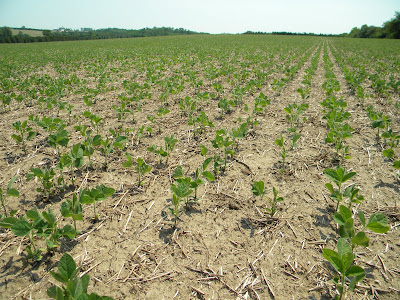Have you seen soybean fields this year that look like this one? I have, more than once. Fields of drilled soybeans with good rows beside blank rows. Seen mostly on conventional tillage, but also on a few reduced tillage fields. You would swear the drill was starting to run empty.
What happened? There is only one answer. Inconsistent seed depth placement between the seed openers on the drill. I have not seen this same problem on any field planted with a row unit planter. Conventional tilled loam and silt loam soils were tricky this spring. They were extremely mellow and soft, mostly because these soils dried early and had no pounding spring rains to settle them down. It was easy to get soybeans planted too deep and the drill was an enemy. It is a real pain in the rear checking seed depth placement behind a drill.
1.Depth placement is not consistent within the row.
2.Many of us do not have the patience to check every row.
3.Where in the field do you check?
If you happened to check on a firm headland and thought things were fine, you would be badly fooled in the soft soil off the headland. In fact, it was a year to pack the soil in front of the drill, not behind it.
Curtis Gartly and Ron Murrell sent me the following photos of soybeans that were planted too deep. The field looked like the one above. The customer referred to them as "retarded beans".
I have been in the agronomy arena for many years and 95% of corn emergence and growth problems are created by planting corn too shallow. With soybeans, there is a much higher probability that the problem is caused by planting too deep. We can get away with planting corn 3'" deep in loamy seed beds and not be hurt. BUT, we cannot get away with planting soybeans 3" deep. They break their backs and fold up like an accordion. Pioneer rates all of their varieties by length of hypocotyl. The hypocotyl is what you see in the picture on the shovel. It is the part of the bean that pushes the seed up through the soil. Some varieties have longer hypocotyls than others.
These are the hypocotyl ratings of Pioneer varieties grown in this area.
90M40 Long
91M01 Medium
91Y20 Long
91M41 Short
91Y80 Long
91Y90 Medium
In other words, if you plant 91M41's you need to pay very close attention to seed depth. 90M40's on the other hand are a little more forgiving. But no soybean variety emerges well from 3" deep.
Fortunately, soybeans do not penalize badly for weak stands and some folks will continue their sloppy practices.
Retarded beans? Retarded drills? An agronomist I know referred to drills once as "controlled spill devices". He was exactly right.
.JPG)


.JPG)

















